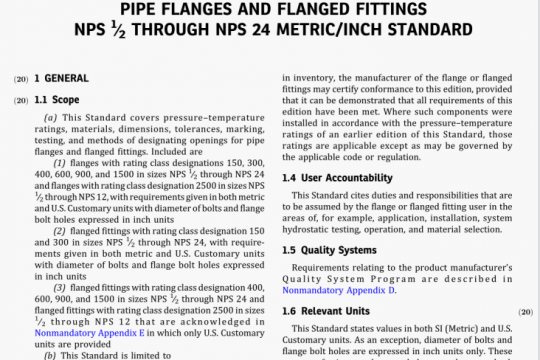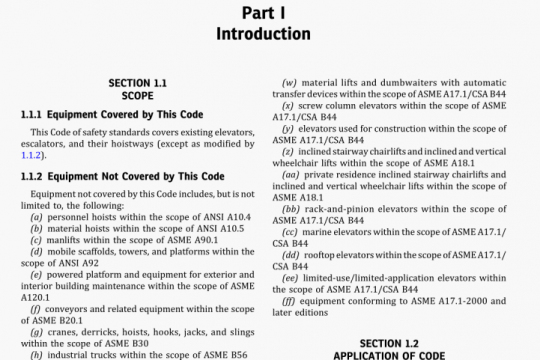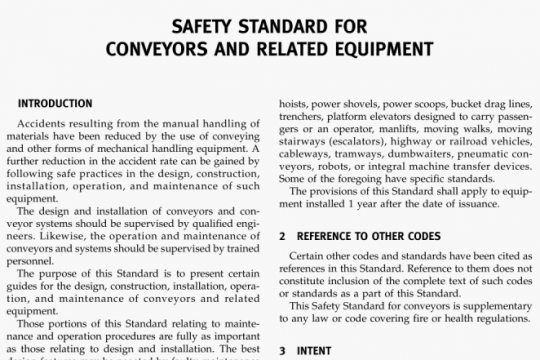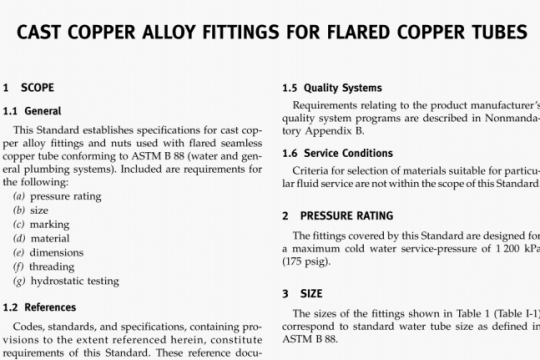ASME B16.42-2016 pdf free
ASME B16.42-2016 pdf free.Ductile lron Pipe Flanges and Flanged Fittings.
Drilling, Outside Diameter, Thickness, and Facing Dimensions. Flange drilling, outside diameter, thickness, and facing are the same as those of the standard flange of the size from which the reduction is being made.
Threaded flanges. The huh dimensions shall be at least as large as those of the standard flange of the size from which the reduction is being made. The hub may be larger or may be omitted, as detailed in Table 2.
Threads for Threaded Flanges
Threaded flanges shall have American National Standard pipe threads, general purpose (inch), conforming to ANSI/ASME B1.20.l. The thread shall beconcentric with the axis of the flange, and variations in alignment shall not exceed 5 mm/rn (0.06 in./ft) (0.5%).
Class 150 FLanges. Class 150 flanges are made without a counterbore. The threads shall be chamfered approximately to the major diameter of the thread at the back of the flange at an angle of approximately 45 deg with the axis of the thread, to afford easy entrance in making a joint and to protect the thread. The chamfer shall be concentric with the thread and shall be included in the measurement of the thread length.
Class 300 flanges. Class 300 flanges may be made with a counterbore. The threads shall be chamfered to the diameter of the countert,ore at the back of the flange at an angle of approximately 45 deg with the axis of the threads to afford easy entrance in making a joint. The counterbore and chamfer shall be concentric with the thread.
Length of Threads. The minimum length of effective thread in reducing flanges shall be at least equal to dimension “Length of Thread” of the corresponding pressure class threaded flange as shown in the tables, hut does not necessarily extend to the face of the flange. See Table 2 for reducing threaded flanges.
Threading Tolerances. The gaging notch of the working gage shall come flush with the bottom of the chamfer in all threaded flanges, and shall be considered as the intersection of the chamfer cone and the pitch cone of the thread. This depth of chamfer is approximately equal to one-half the pitch of the thread. The maximum allowable thread variation is one turn large or small from the gaging notch.
Stud Bolts, Bolts, and Nuts
Alloy Bolting. Alloy steel stud boils, threaded at both ends or full length, or heavy hex bolts may be used. Heavy hex nuts shall be used with all alloy steel bolting.
Carbon Steel Bolting
(a) Bolts smaller than diameter shall have square heads or heavy hex heads. Nuts shall be heavy hex.
(b) Bolts 34 diameter and larger shall have square heads or hex heads. Nuts shall be hex or heavy hex.
Bolt Dimensions. Dimensions of all bolts shall conform to ASME B18.2.1.
Nut Dimensions. Dimensions of all nuts shall conform to ASME B18.2.2.
ThreadIng of Bolts
(a) Carbon steel bolting shall be threaded in accordance with ASME 81.1, coarse thread series, Class 2A for bolts and stud bolts, and Class 28 for nuts.
(b) Alloy steel bolting shall be threaded in accordance with ASME B1.l. Nominal diameters 1 in. and smaller shall be of the coarse thread series; nominal diameters i!4 in. and larger shall be of the 8-thread series. Bolts, studs, and stud bolts shall have Class 2A dimensions; nuts shall have Class 2B dimensions.
Gaskets for Class 150 flat lace flanges shall conform to the dimensions shown in ASME Bl6.21. For flanges with raised face, gaskets shall conform to ASME 816.5, Nonmandatory Appendix B, Limiting Dimensions of Gaskets Other Than Ring Joint Gaskets, Group Ia.
Pipe Thread Tapping. Holes may be tapped in the wall of a fitting if the metal is thick enough to allow the effective thread length specified in MSS SP-45. Where thread length is insufficient or the tapped hole needs reinforcement, a boss shall be added.ASME B16.42 pdf free download.




